| Ultraviolet Bird Photography |
| ABOUT IMAGES BIRD VISION VIDEOS |
![]()
Color Perception in Humans and Birds
The human eye has special cells in the retina, which can sense red, green, and blue light. Every color that we can see is made up of some combination of these three "primary" colors. For example, yellow is a combination of red and green. White is a combination of red, green, and blue. The same "RGB" color system is used in cameras and computer screens. Since the camera works like the human eye, it can capture every color that the human eye can see. You can adjust the sliders below, to see how any color can be made through various combinations of red, green, and blue. Since every color is a combination of three components, color is said to have three dimensions.
Typical cameras can
sense red, green, and blue light. Every color in a photo is made up of
some combination of these three "primary" colors. For example,
yellow is a combination of red and green. White is a combination of red,
green, and blue. This "RGB" color system mimics the human eye.
We have special cells in the retina of the eye, called "cones",
which detect red, green, or blue light. Since the camera works like the
human eye, it can capture every color that the human eye can see. You
can adjust the sliders below, to see how any color can be made through
various combinations of red, green, and blue.
Since every color is a combination of three components, color is said to have three dimensions. By adding the ultraviolet sensor, we create a four-color or tetrachromatic imaging system. This mimics the function of the bird's eye, which can perceive ultraviolet light, as well as red, green, and blue.
Each of the retina cells, called cones, can actually detect light over a broad range of wavelengths. The sensitivities overlap so that a pure yellow light of 550 nm will activate both the red and the green cones. However, a yellow object typically reflects a broad range wavelengths, covering the red and green part of the spectrum. The diagram below shows the wavelength senstivities of the three types of cones in the human eye.
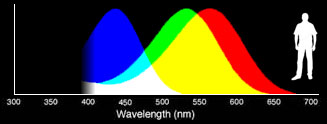 Wavelength sensitivities of the blue, green, and red cones in the human eye. |
|
 Wavelength sensitivities of the four types of cones in the eye of a bird. |
Birds have the same three types of cones in the retina. But they also have a fourth type, which detects ultraviolet light. (Not all birds can see ultraviolet. In some birds, the fourth cone detects violet light instead.) For birds, color has four dimensions. They can see a multitude of different colors that we humans cannot see or even imagine.
The special camera system that I am using has an ultraviolet image sensor in addition to the RGB sensor of a typical digital camera. By adding the ultraviolet sensor, we create a four-color or tetrachromatic imaging system. This mimics the function of the bird's eye, which can perceive ultraviolet light, as well as red, green, and blue.
Converting for the Human Eye
One of the challenges of my work has been to find the best way to present the four-dimensional color information to the human eye. Inevitably, some information is lost in the process, as we simply cannot perceive four dimensions of color. Here is a summary of the methods I have tried, with their advantages and disadvantages.
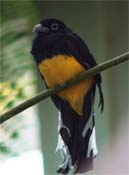 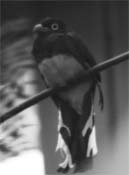 stereogram |
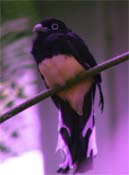 color overlay |
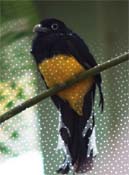 texture overlay |
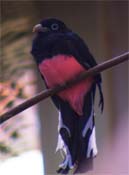 reassignment |
Stereogram. Originally I planned to present the images as stereograms, where one eye would take in the RGB channels, and the other eye would take in the ultraviolet. In principle, this method would allow the human to see four color channels at the same time. In practice, the human visual system cannot interpret color information from the paired images.
Color Overlay. Another thought was to overlay a purple color (or some other color) onto the image to represent ultraviolet. It's possible to produce some neat effects this way, but it's misleading, because ultraviolet isn't really purple. Also, the overlay doesn't combine with other colors in a natural way. In this example, the tail feathers should appear white, not UV-colored.
Texture Overlay. Finally, I devised a way to show the four dimensions of the avian color system. Our eyes can see only three dimensions of color, but we can perceive a fourth dimension, which is texture. By overlaying a textured pattern onto the image, I was able to show the fourth dimension, the ultraviolet light. This is done without affecting the visible colors that we know and love. However, the texture overlay can miss fine details like the narrow eye ring on this bird.
Reassignment. This is the method of squeezing the image into a smaller portion of the spectrum, which I have used in the photo gallery. Although we lose the four-dimensional aspect of bird vision, this method produces some beautiful images. Although familiar colors are shifted toward the red end of the spectrum, the ultraviolet combines with visible light in a very natural way to reveal new color combinations that were previously hidden to our human eyes.
© Nathan Chronister for permission